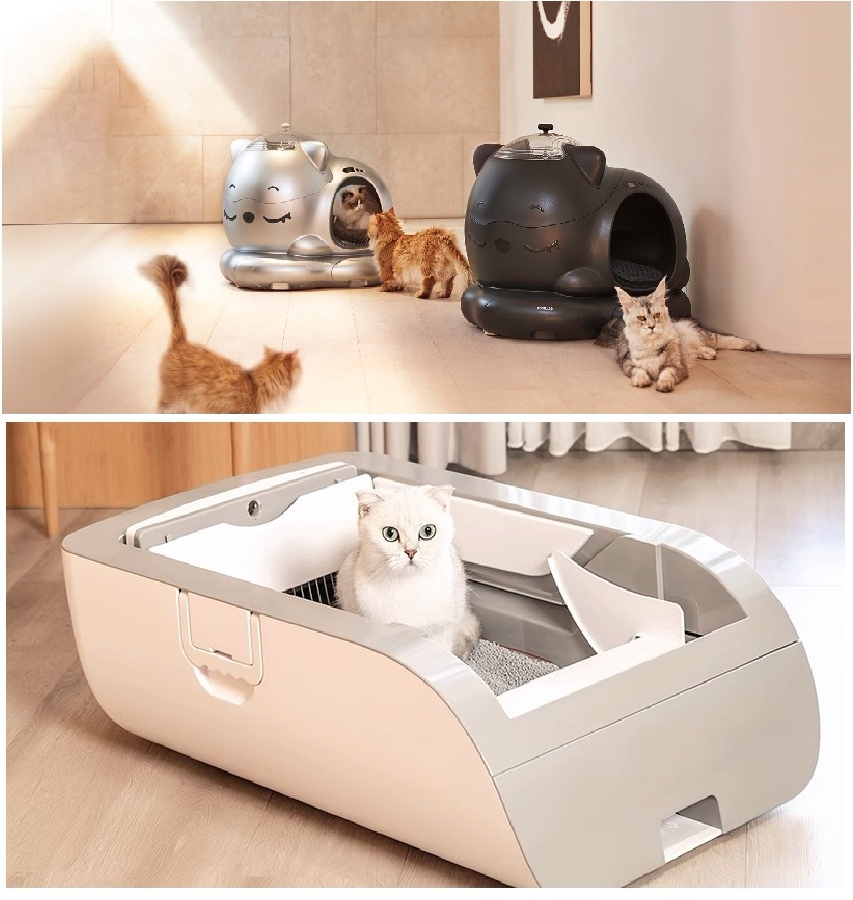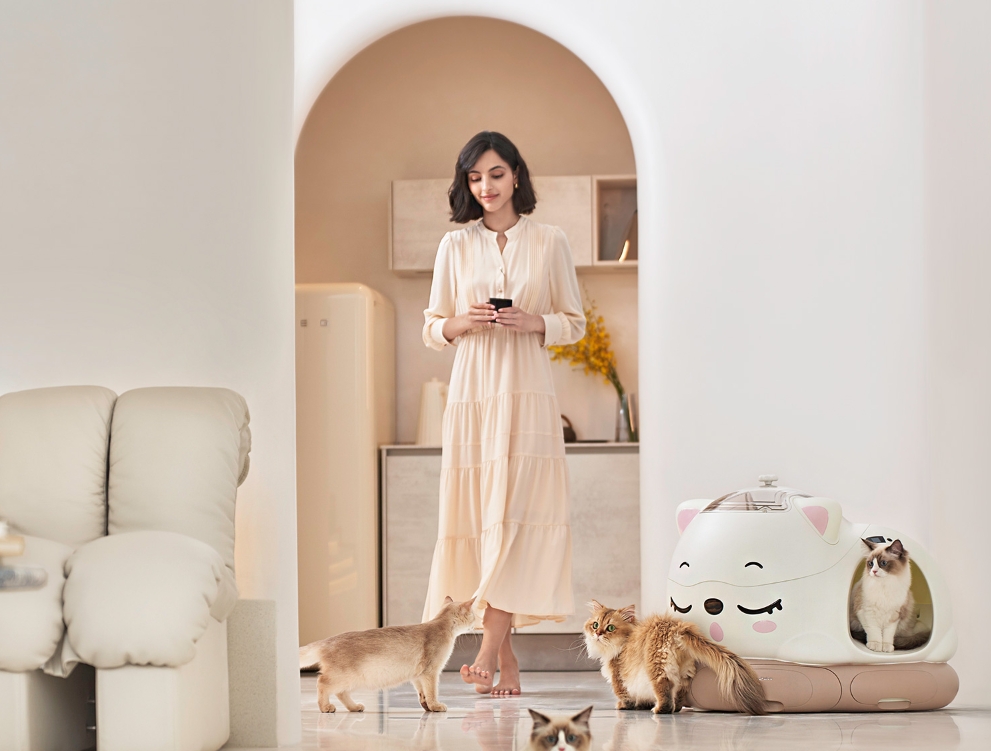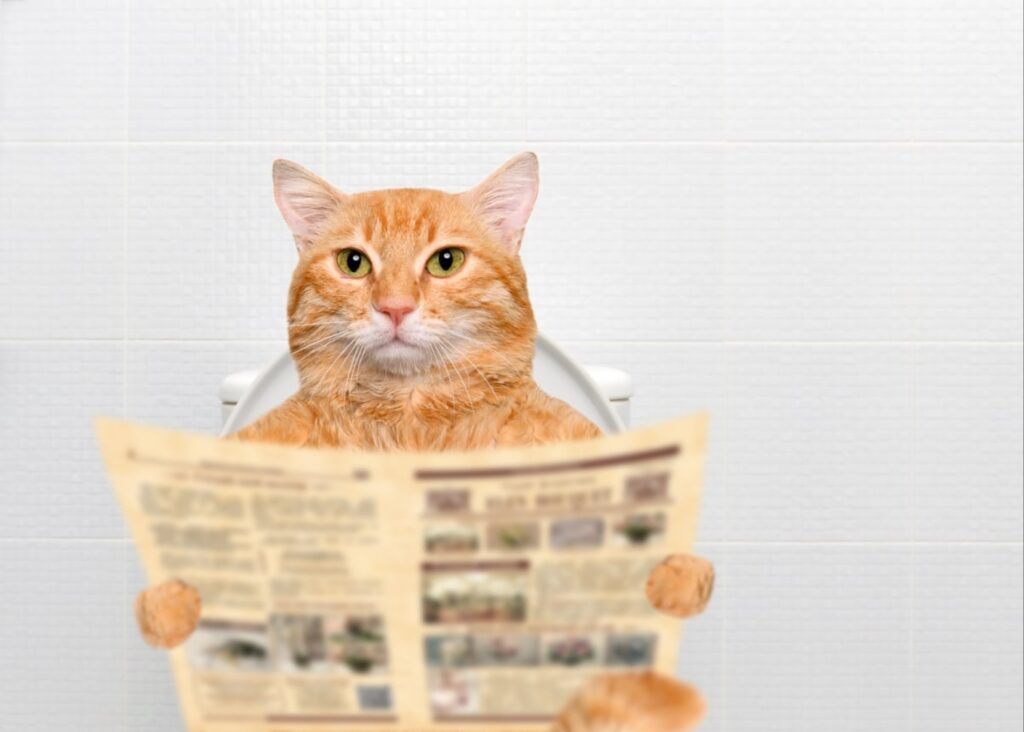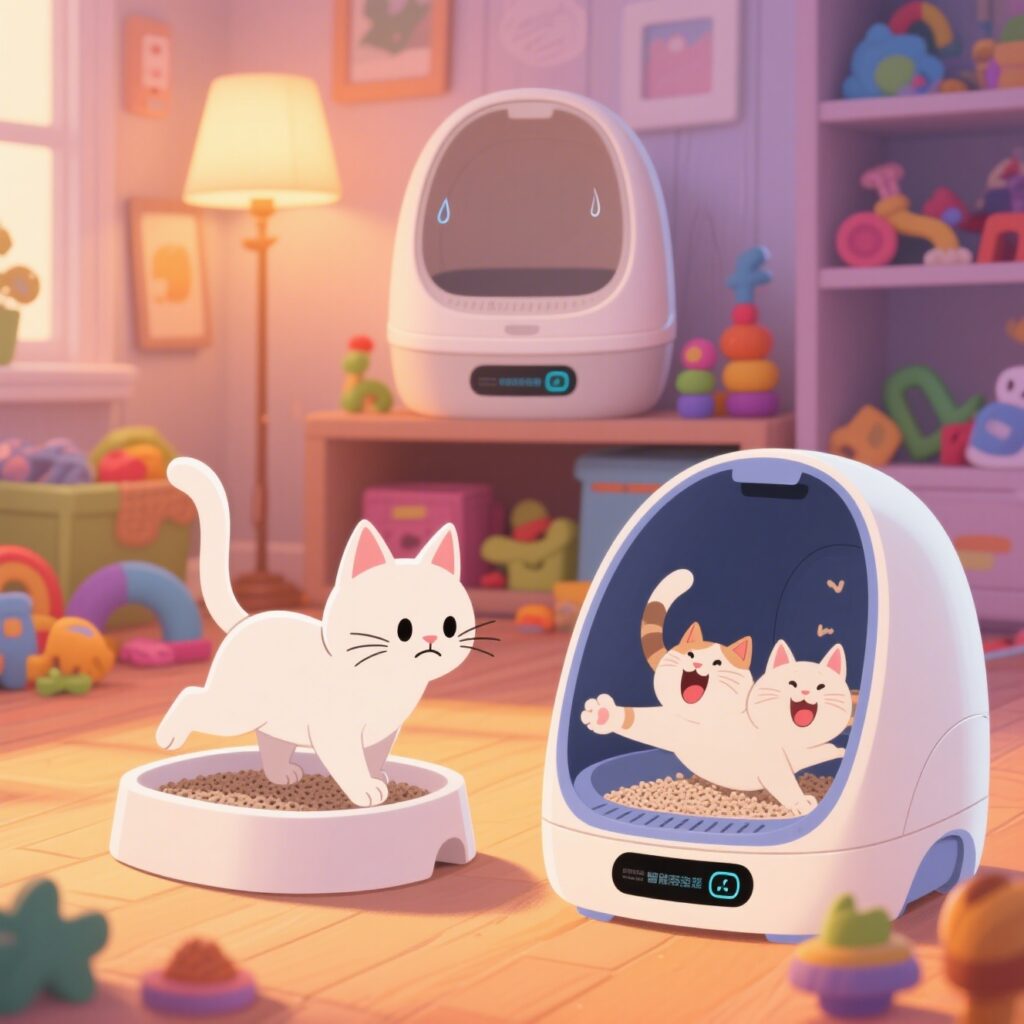Introduction: Why Cleaning Technology Matters in Smart Litter Boxes
Litter box cleaning can be more than just a chore; it’s a responsibility that directly affects our furry friends’ comfort and health. Imagine dealing with that familiar, pungent odor because of residual litter or clumps that breed bacteria—ew! Plus, think about the time-consuming manual scooping and the poor kitties startled by the loud noise of some machines that can make them refuse to use it altogether.
This is where innovative cleaning technologies come in, elevating the litter box experience for both cats and owners alike. Leading the charge are two main contenders in the tech world: the Biomimetic Flat-Shovel, with its mechanical arm and tracks, and the Drum Screening system, boasting a rotating mesh. Both aim to tackle the core pain points of litter box cleaning through different technological pathways. Let’s dive into their specifics and see why they could be game-changers in your everyday cat care!
Technical Principles: Biomimetic Flat-Shovel vs. Drum Screening

In the exciting world of smart litter box technology, two distinct designs have emerged to cater to the needs of cat owners who crave innovation and convenience: the Biomimetic Flat-Shovel and the Drum Screening. Each design boasts its own unique method of addressing the age-old chore of litter box cleaning. Let’s explore how these two technologies operate and the magic behind their core structures.
Flat-Shovel Design: Mimicking Human Scooping
The Flat-Shovel system is an inventive approach that mimics the traditional method of human scooping but with a modern twist. This design integrates military-grade tank track mechanics, utilizing a track-based transmission system. The dual-gear interlocking mechanism ensures a precision straight-line movement with an error margin of under 0.5mm. Imagine your litter box performing with the exactitude of a Swiss watch!
The Flat-Shovel uses biomimetic shovel teeth with 8mm spacing made from soft, adaptable silicone. This design allows the shovel to conform to different clump shapes, minimizing adhesion and ensuring thorough cleaning. The workflow is a seamless process: once the cat exits, the shovel advances linearly, fully transferring clumps and sliding them effortlessly into the waste bin. It’s like having a reliable, neat-freak friend who cleans up right after the party.
Drum Design: Gravity-Driven Filtration
The Drum Design takes a different approach, relying on the natural force of gravity to separate waste from clean litter. The central feature here is a rotating drum equipped with a motor-driven mesh with holes ranging from 10 to 15mm. It operates on a simple yet effective principle of size-based separation.
As the drum rotates continuously, the mesh “scrapes” the waste clumps, allowing them to drop through the holes into the waste bin below, while the finer, clean granules of litter sift back into the main chamber. It’s recycling at its best, using gravity to your advantage, so you spend less time elbow-deep in litter and more time enjoying your furry friend’s company.

Performance Comparison: Efficiency, Noise, Compatibility
When it comes to smart litter boxes, performance is key. Whether you’re interested in cleaning speed, noise levels, or compatibility with multiple cats, both the Flat-Shovel and Drum systems offer different benefits.
Efficiency Metrics
| Parameter | Flat-Shovel (Lab Data) | Drum (Lab Data) |
| Cycle Time | 8-10 mins (full cleanup) | 4-6 mins |
| Clump Integrity | 99% (no fragmentation) | 60%-75% |
| Litter Residual Rate | <1% | 15%-30% |
In terms of efficiency, one of the most critical metrics is cycle time. The Flat-Shovel system completes a full cleaning cycle in 8 to 10 minutes, making sure no clump is left behind. On the other hand, the Drum system boasts a faster cycle time of just 4 to 6 minutes. But hold your horses, it comes with a caveat: while the Flat-Shovel ensures a pristine 99% clump integrity with virtually no fragmentation, the Drum lags, offering only 60% to 75% clump integrity. This might leave you dealing with bits and pieces more often.
The litter residual rate is another key factor in efficiency. The Flat-Shovel tends to leave less than 1% litter residual, while the Drum system has a higher residual rate of 15% to 30%. If maximum cleanliness is your priority, these numbers might steer you towards the Flat-Shovel’s precise performance.
Noise Pollution
Noise levels might seem like a minor concern, but for sound-sensitive kitties, it can make all the difference. The Flat-Shovel triumphs again, with its track motion powered by a low-RPM motor, producing comfortably gentle noise levels at or below 40dB. This is comparable to whispers in a library, ensuring that your cat won’t be startled during their bathroom breaks.
Flat-Shovel: Track motion + low-RPM motor → ≤40dB (library-quiet)
Conversely, the Drum’s high-speed motor and the sound of mesh collisions can reach noise levels of at least 50dB, akin to the noise of a running vacuum cleaner. This can be less than ideal, especially for cats who are easily spooked.
Drum: High-speed motor + mesh collisions → ≥50dB (vacuum-level).
Compatibility Testing
When it comes to multi-cat households or dealing with various types of waste, compatibility is paramount. The Flat-Shovel has been tested on a 10kg Ragdoll cat and demonstrated zero adhesion, showing its adaptability to long-haired or heavy-shedding breeds.
However, the Drum system faces challenges under similar conditions. After just three uses, the filter starts clogging, which can be a problem for households with several felines.
For dealing with soft stool, the Flat-Shovel once again showcases its superiority. It can remove such waste intact with no resulting odor. In contrast, the Drum system often results in fragmented clumps that can perpetuate unpleasant stenches, not the most welcomed aroma in any house.
As each pet owner knows, differences in designs can affect performance greatly, and understanding these technical principles and performance metrics can guide you in choosing the most suitable smart litter box for you and your pet. In the next sections, we will delve deeper into other aspects such as safety, cost, and serviceability to round out the comparison between these innovative cleaning technologies. Stay tuned for more insights!
Functional Experience: Cleaning Ease, Safety, Cost
When it comes to the world of smart litter boxes, the flat-shovel and drum designs each have their own set of unique strengths and weaknesses. Let’s dig into the nitty-gritty — looking at serviceability, safety engineering, and the total cost of ownership — to get a clearer picture of how each system excels and where it might fall short.
Serviceability
The ease of cleaning is a big deal when it comes to litter box maintenance. Nobody wants to spend their precious time wrestling with complicated gadgetry when a simple cleanup is required, right?
– Flat-Shovel: One of the standout features of the flat-shovel design is its tool-free disassembly. Picture this: you can remove the shovel in three seconds flat, and the track surface is smooth, facilitating a quick rinse that takes only about a minute. This straightforward design choice means that the flat-shovel is easy to maintain, allowing more time for cuddles and play with your furry friend.
– Drum: The drum, on the other hand, demands a bit more dedication when it comes to maintenance. Its mesh-fusion design means that cleaning up residue might take over five minutes and typically involves using tools. Plus, there are hidden dead zones where residue can accumulate, necessitating a brush for thorough cleaning. It’s not as quick or intuitive, adding a bit of a chore-like feel to the process.

Safety Engineering
Safety is non-negotiable, as any pet parent would tell you. Your pet has to be comfortable and secure, especially in spaces like the litter box where they need to feel completely at ease.
– Flat-Shovel: This system boasts impressive safety features. Utilizing infrared and touch braking, the flat-shovel can reverse in just 0.1 seconds if it detects an intrusion, avoiding harm with its soft, rounded edges. This level of detail ensures peace of mind for both you and your cat, minimizing risks of injury.
– Drum: Unfortunately, safety is not the drum’s strong suit. The rotating mesh and multiple openings create potential shear zones, which could increase the injury risk by 200%. Alarming as that might sound, it’s made worse by the absence of an emergency stop function. There have been documented incidents where cats have suffered injuries due to these shortcomings, so careful consideration is needed when evaluating this option.
Total Cost of Ownership
Budgeting for pet care doesn’t stop at food and vet visits — technology for their convenience also adds up. Let’s see how the flat-shovel and drum compare in terms of ongoing costs.
– Flat-Shovel: With an energy cost of about $18 annually (thanks to its low power consumption of 0.05kWh/day) and consumables (like bags) totaling $30 per year, the flat-shovel is pretty economical. Moreover, it has a low repair rate of less than 5% over two years, pointing to robust build quality.
– Drum: The drum requires more from your pocket. Annually, expect to shell out about $36 for energy and a notable $130 for consumables (mesh and deodorizer replacements). Plus, with a whopping 35% repair rate over the same period, its maintenance tend to cut deeper into household budgets.
| Category | Flat-Shovel (Annual) | Drum (Annual) |
| Energy Cost | $18 (0.05kWh/day) | $36 (0.1kWh/day) |
| Consumables | $30 (bags) | $130 (mesh+deodorizer) |
| Repair Rate (2Y) | <5% | 35% |
Design Aesthetics & Energy Efficiency
Now that we understand the practicalities, let’s dive into the design aspects and energy use of these smart litter boxes. After all, they’re going to become a part of your home’s landscape as much as they serve a practical function.
Aesthetic Philosophy
A litter box doesn’t have to be an eyesore, and both designs have their own take on how to integrate seamlessly into your living space without compromising functionality.
– Flat-Shovel: This design embraces openness with a visible waste bin, allowing you to monitor its fullness at a glance. The accessibility and transparency of this setup are great for ensuring your litter box gets the attention it needs in time.
– Drum: In contrast, the drum design goes for an enclosed shell. While this might help with noise reduction and masking grime, it also means you have hidden areas where mess and odors could lurk unchecked until it’s too late.
Power Consumption
Eco-consciousness is on many of our minds nowadays — and using energy efficiently is a part of that. Little things add up, and knowing the energy demands of your gadgets can make a difference.
– Flat-Shovel: It impresses with a low power consumption rate of 0.02kWh per cycle, roughly equivalent to a single phone charge. This not only supports modest energy bills but aligns with a sustainable lifestyle.
– Drum: The drum, however, consumes more energy with each use, drawing 0.05kWh per cycle. That’s nearly double the power consumption, which could, over time, impact your bills and carbon footprint more than you’d wish.
As we weigh these aspects together, it’s clear that the flat-shovel design stands out in several key ways, particularly with its cost-effectiveness, ease of service, and user-friendly safety features. Meanwhile, although the drum design may suit certain budget-driven and simpler scoop-friendly households, it doesn’t always align with high security and maintenance efficiency.
If you’re thinking practically and value reliability, the flat-shovel makes a compelling case. However, personal circumstances such as budget constraints or unique aesthetic preferences could sway some cat lovers toward the drum option. Ultimately, the decision will depend on what you prioritize for your feline family member’s comfort and your lifestyle.

Buying Guide: Match Your Needs
When it comes to choosing between a flat-shovel and a drum litter box, your household’s specific needs should guide your decision. Let’s break down who might benefit most from each technology.
Ideal Flat-Shovel Users
The flat-shovel model shines with its meticulous design and user-friendly experience. Here’s who might fall in love with this option:
– Multi-Cat and Long-Haired Households: If you’re juggling multiple furbabies or dealing with long-haired breeds, the flat-shovel’s advanced technology is a game-changer. With its low adhesion rate, you won’t deal with litter clumping in unwanted places or hair getting caught up.
– Small Apartments and Night Owls: Living in cozy quarters where every sound is magnified? The flat-shovel’s whisper-quiet operation, which is as peaceful as a library at ≤40dB, makes it ideal for such environments. It won’t wake you or your felines during late-night hours.
– Zero-Residue Purists: If you refuse to compromise on cleanliness and hygiene, this option has you covered. The flat-shovel maintains a litter residual rate of less than 1%, ensuring your litter box stays as fresh and clean as possible.
These key advantages make flat-shovel designs a top pick for cat owners who demand the best in tech-driven cleanliness and peace of mind.
Drum’s Niche
Drum litter boxes aren’t without their own set of merits. Here’s the crowd they most appeal to:
– Budget-Conscious Singles: If you’re flying solo and looking for a cost-effective option, the drum litter box can fit the bill. The lower upfront costs, coupled with the willingness to engage in partial scooping, make it a viable choice.
– Minimalist Maintenance Lovers: For those who prefer gadgets that require less intervention, the drum’s rotating mechanism can handle regular litter turnover without needing constant human interaction. Just be prepared for some trade-offs in terms of noise and residue management.
Although the drum may not suit every cat owner’s needs, its simple operation and lower purchase price offer an attractive option for individuals willing to compromise on a few features for affordability.
2025 Innovations
The world of smart litter box technology continues to evolve. Looking ahead, both flat-shovel and drum models have exciting innovations on the horizon for 2025, designed to enhance user experience and efficiency.
– Flat-Shovel Innovations: Expect AI pressure sensors that adapt to varying stool consistencies, addressing one of the most common challenges in maintaining a pristine litter box. By intelligently adjusting its operation, the flat-shovel design is pushing boundaries in ensuring thorough and odor-free cleaning.
– Drum Advances: Drums are not lagging behind either. Ultrasonic mesh self-cleaning is the buzz in the drum community, currently in the research and development phase. This innovation promises to reduce manual cleaning efforts by automatically managing mesh buildup and debris, offering a hands-off experience.
Whether you’re drawn to the precision of the flat-shovel or the simplicity and cost-effectiveness of the drum, these advancements underscore the ongoing commitment to improving pet care technology. As manufacturers continue to innovate, cat owners can look forward to even more efficient, effective, and user-friendly litter box solutions.
Choosing the right litter box isn’t just about the latest technology—it’s about matching that tech with your lifestyle and the unique needs of your feline family members.
Conclusion: Design Excellence = Cat-Centric Harmony
In the grand arena of smart litter box cleaning technologies, the flat-shovel design shines as a true champion. Its prowess lies in its cat-centric approach that elegantly respects our feline friends’ natural instincts. By ensuring intact clumps, the flat-shovel satisfies a cat’s need to bury, reducing stress and promoting happiness.
The whisper-quiet operation of the flat-shovel is a testament to its design brilliance, safeguarding cats’ acute sense of hearing—which is four times more sensitive than ours. With an open design, cats maintain environmental control and feel at ease, contributing to a harmonious living space for both pet and owner.
As pet technology engineers wisely note, “The best machines are invisible to cats.” The flat-shovel technology beautifully embraces this philosophy, ensuring that cleaning the litter box becomes a seamless and stress-free experience for all involved.
he true victor isn’t Flat-Shovel or Drum—it’s the cat who never steps on clumps again. Join the Revolution
Share Your Battle Story by comments below!







